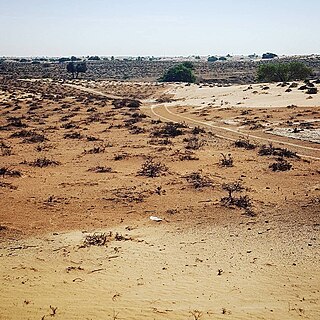
Vologases III was king of the Parthian Empire from 110 to 147. He was the son and successor of Pacorus II.

Elymais or Elamais was an autonomous state of the 2nd century BC to the early 3rd century AD, frequently a vassal under Parthian control. It was located at the head of the Persian Gulf in Susiana. Most of the population probably descended from the ancient Elamites, who once had control of that area.

Characene, also known as Mesene (Μεσσήνη) or Meshan, was a kingdom founded by the Iranian Hyspaosines located at the head of the Persian Gulf mostly within modern day Iraq. Its capital, Charax Spasinou, was an important port for trade between Mesopotamia and India, and also provided port facilities for the city of Susa further up the Karun River. The kingdom was frequently a vassal of the Parthian Empire. Characene was mainly populated by Arabs, who spoke Aramaic as their cultural language. All rulers of the principality had Iranian names. Members of the Arsacid dynasty also ruled the state.

Charax Spasinu, also called Charax Spasinou, Charax Pasinu, Spasinu Charax, Alexandria or Antiochia in Susiana, was an ancient port at the head of the Persian Gulf in modern day Iraq, and the capital of the ancient kingdom of Characene.
Shimal is the name of a settlement in Ras Al Khaimah, United Arab Emirates. It is associated with the Shihuh tribe of the Northern UAE and Oman and with the foundation of the Islamic era port of Julfar, and was once the seat of the Ruler of Julfar. It is also the location of an important archaeological site dating back to the Umm Al Nar culture.
Midianite pottery, also known as Qurayya ware is a ware type found in the Hejaz, southern and central Jordan, southern Canaan and the Sinai, generally dated to the 13th-12th centuries BCE, although later dates are also possible.
Khanfar is a district that is a southern the Abyan Governorate of south-western Yemen. It is said to be inhabited by Yafa peoples.
Axidares or Ashkhadar also known as Exedares or Exedates was a Parthian prince who served as a Roman client king of Armenia.

Parthamasiris, also known as Partamasir or Parthomasiris was a Parthian prince who served as a Roman client king of Armenia.

Attambelos II was a king of Characene, a Parthian vassal state and important trading port on the Persian Gulf. His rule was from 17/16 to 9/8BC.

Maga was a King of Characene a vassal state of the Parthian Empire and important trading city in the Persian Gulf.
Attambelos may refer to the following kings of the Parthian vassal state of Characene:

Attambelos IV of Characene was a first century ruler of the state of Characene, centered on the northern end of the Persian Gulf. His capital was probably Charax.

Attambelos V of Characene was a ruler of the state of Characene who ruled from 64/65–73/74 but who is known only from the coins he minted.

Attambelos VI of Characene was a ruler of the state of Characene, who ruled from approximately 101/02-105/06 and is known only from the coins he minted.

Ed Dur, also known as Al Dour and Ad Dour is an Ancient Near Eastern City, today located in Umm Al Quwain, in the United Arab Emirates (UAE). One of the largest archaeological sites in the emirates, comprising an area of some 5 km2 (1.9 sq mi), the coastal settlement overlooks Al Beidha Lake. One of the most important archaeological finds in the UAE, and closely associated with the inland trading centre of Mleiha, Ed Dur has been dubbed 'one of the most significant lost cities of Arabia'.

Theonesios III of Characene was a king of Characene who ruled from approximately 52AD. His rule is known only by the coins he minted.

Theonesios II of Characene was a 1st century king of the kingdom of Characene located at the mouth of the Tigris-Euphrates rivers during antiquity. He ruled for only a few months in 46/47AD. His rule is known only by the coins he minted.

Wahbarz, known in Greek sources as Oborzos, was a dynast (frataraka) of Persis in the 1st half of the 2nd century BC, ruling from possibly c. 205 to 164 BC. His reign was marked by his efforts to establish Persis as a kingdom independent from Seleucid authority. He was able to reign independently for three decades, and even expanded to the west, seizing the Seleucid province of Characene. In 164 BC, the Seleucids repelled Wahbarz's forces from Characene, forcing him to re-submit as a Seleucid vassal. He was succeeded by Baydad.
Daniel T. Potts, FBA, is an American historian and archaeologist.











